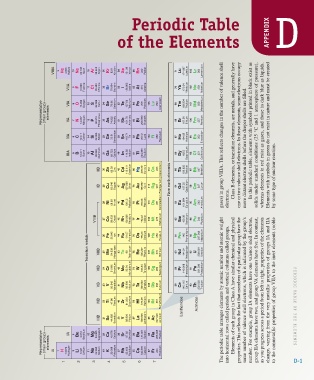Page 712 - Environment: The Science Behind the Stories
P. 712
Periodic Table d
of the Elements APPENDIX
VIIIA 2 He 4.003 Helium 10 Ne 20.180 Neon 18 Ar 39.948 Argon 36 Kr 83.8 Krypton 54 Xe 131.29 Xenon 86 Rn 222 Radon 71 Lu 174.967 Lutetium 103 Lr 262 Lawrencium
VIIA 9 F 18.998 Fluorine 17 Cl 35.453 Chlorine 35 Br 79.904 Bromine 53 I 126.905 Iodine 85 At 210 Astatine 70 Yb 173.04 Ytterbium 102 No 259 Nobelium
Representative (main group) elements VIA VA 8 7 O N 15.999 14.007 Oxygen Nitrogen 16 15 S P 32.066 30.974 Sulfur Phosphorus 34 33 Se As 78.96 74.922 Selenium Arsenic 52 51 Te Sb 127.60 121.76 Tellurium Antimony 84 83 Po Bi 209 208.980 Polonium Bismuth 116 Lv 293 Livermorium 69 68 Tm Er 168.934 167.26 Thulium Erbium 101 100 Md Fm 258 257 Mendelevium Fermium
IVA 6 C 12.011 Carbon 14 Si 28.086 Silicon 32 Ge 72.61 Germanium 50 Sn 118.71 Tin 82 Pb 207.2 Lead 114 Fl 289 Flerovium 67 Ho 164.93 Holmium 99 Es 252 Einsteinium gases) in group VIIIA. This reflects changes in the number of valence shell Class B elements, or transition elements, are metals, and generally have one or two valence shell electrons. In these elements, some electrons occupy In this periodic table, elements with symbols printed in black exist as solids under standard conditions (25 °C and 1
IIIA 5 B 10.811 Boron 13 Al 26.982 Aluminum 31 Ga 69.723 Gallium 49 In 114.82 Indium 81 Tl 204.383 Thallium 66 Dy 162.5 Dysprosium 98 Cf 251 Californium more distant electron shells before the deeper shells are filled.
IIB 30 Zn 65.39 Zinc 48 Cd 112.411 Cadmium 80 Hg 200.59 Mercury 112 Cn 285 Copernicium 65 Tb 158.925 Terbium 97 Bk 247 Berkelium by some type of nuclear reaction.
IB 29 Cu 63.546 Copper 47 Ag 107.868 Silver 79 Au 196.967 Gold 111 Rg 281 Roentgenium Rare earth elements 64 Gd 157.25 Gadolinium 96 Cm 247 Curium
28 Ni 58.69 Nickel 46 Pd 106.42 Palladium 78 Pt 195.08 Platinum 110 Ds 281 Darmstadtium 63 Eu 151.964 Europium 95 Am 243 Americium electrons.
VIIIB 27 Co 58.933 Cobalt 45 Rh 102.906 Rhodium 77 Ir 192.22 Iridium 109 Mt 278 Meitnerium 62 Sm 150.36 Samarium 94 Pu 244 Plutonium
Transition metals VIIB 26 25 Fe Mn 55.845 54.938 Iron Manganese 44 43 Ru Tc 101.07 98 Ruthenium Technetium 76 75 Os Re 190.23 186.207 Osmium Rhenium 108 107 Hs Bh 269 270 Hassium Bohrium 61 60 Pm Nd 145 144.24 Promethium Neodymium 93 92 Np U 237.048 238.029 Neptunium Uranium
VIB 24 Cr 51.996 Chromium 42 Mo 95.94 Molybdenum 74 W 183.84 Tungsten 106 Sg 269 Seaborgium 59 Pr 140.908 Praseodymium 91 Pa 231.036 Protactinium
VB 23 V 50.942 Vanadium 41 Nb 92.906 Niobium 73 Ta 180.948 Tantalum 105 Db 268 Dubnium 58 Ce 140.115 Cerium 90 Th 232.038 Thorium The periodic table arranges elements by atomic number and atomic weight Elements of each group in Class A have similar chemical and physical properties. This reflects the fact that members of a particular group have the same number of valence shell electrons, which is indicated by the group’s number. For example, group IA elements have one valence shell electron, group
IVB 22 Ti 47.88 Titanium 40 Zr 91.224 Zirconium 72 Hf 178.49 Hafnium 104 Rf 267 Rutherfordium Lanthanides Actinides into horizontal rows called periods and vertical columns called groups. Peri odi c Table of T he e lemen T s
IIIB 21 Sc 44.956 Scandium 39 Y 88.906 Yttrium 57 La 138.906 Lanthanum 89 Ac 227.028 Actinium
Representative (main group) elements IA 1 H 1.0079 IIA Hydrogen 4 3 Be Li 9.012 6.941 Beryllium Lithium 12 11 Mg Na 24.305 22.990 Magnesium Sodium 20 19 Ca K 40.078 39.098 Calcium Potassium 38 37 Sr Rb 87.62 85.468 Strontium Rubidium 56 55 Ba Cs 137.327 132.905 Barium Cesium 88 87 Ra Fr 226.025 223 Radium Francium
D-1
1 2 3 4 5 6 7
Z04_WITH7428_05_SE_AppD.indd 1 13/12/14 10:52 AM

